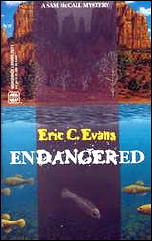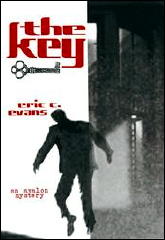July 2009
Monthly Archive
Sun 26 Jul 2009
Posted by Steve under
Reviews[5] Comments
REVIEWED BY DAN STUMPF:
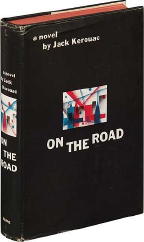
We took a trip around Memorial Day to Williams Arizona, an old cowboy town on Route 66, and thence to the Grand Canyon and Las Vegas, and I spent the rare idle hours reading Jack Kerouac’s 1957 memoir/novel On the Road. Or rather, re-reading it for the first time in 40 years.
Wow.
It’s one of those books that makes you see things differently while you’re reading it. I could never subscribe to the lifestyle (In fact, I spent a big chunk of my life trying to curb those who did.) but Kerouac’s visceral prose is the kind of writing that goes right through the eyes and into the brain.
Every drunk and drug-addict has, when smashed, felt the sensation of discovering something wild and important, deep, secret and beautiful (and how quickly that feeling is lost the next morning!) but Kerouac is one of the few who can get it down on paper and put it across to a relatively sane and completely sober reader.
His characters are wonderfully flawed and brilliantly etched in a few lines, the backgrounds and situations vividly evoked, and the sheer, rambling plotlessness of the thing somehow makes up a startling momentum of its own.
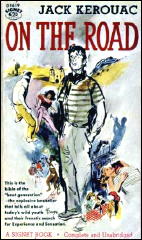
I have to say that this is a book that needs a soundtrack album to go along with it — I had a bit of trouble relating to some of the passages sitting in bars listening to blues, jazz and more blues — but I really fell in love with the scene of the flat-broke Sal Paradise and his friends living for a day and a night in an all-night movie house, sitting among bums and winos, watching the same double-bill over and over again.
I’m tempted to quote the passage as a whole, but just let me throw in:
The picture was Singing Cowboy Eddie Dean and his gallant white horse Bloop. That was number one; number two double feature film was George Raft, Sidney Greenstreet and Peter Lorre in a picture about Istanbul. We saw both of these things six times each during the night. We saw them waking, we heard them sleeping, we sensed them dreaming, we were permeated completely with the strange gray Myth of the West and the weird dark Myth of the East when morning came. All of my actions since then have been dictated automatically to my subconscious by this horrible osmotic experience…
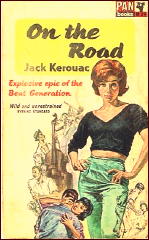
It’s a passage that resonates clearly with the old-movie-buff in me, and one I can relate to, having spent much of my youth sitting in the local grind house for hours on end, letting the Technicolor wash over me as I nursed my adolescent angst.
And I mark it as a sign of Kerouac’s brilliance that a wild and shiftless wanderer like Sal Paradise could reach out and touch a hide-bound old fudd like this one.
Covers shown: The Viking Press, hardcover, 1957. Signet D1619, paperback, 1958. Pan M39, UK, paperback, 1961.
Sun 26 Jul 2009
ONE MYSTERIOUS NIGHT. Columbia, 1944. Chester Morris (Boston Blackie), Janis Carter, Richard Lane, George E. Stone, William Wright, Robert Williams, Mark Roberts, Dorothy Malone (uncredited). Based on the character created by Jack Boyle. Director: Oscar [Budd] Boetticher Jr.
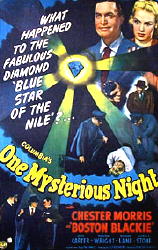
If you were to go back to a review I did quite a while ago, that of Meet Boston Blackie, the first of the series, you’ll see that I wasn’t entirely impressed with it — or if I was, it wasn’t favorably.
I’d happened to have taped a whole run of the Blackie movies at the time, and here it is, over two years later, and last night I finally watched another one, the seventh overall, just so you know where we stand when we start.
And I might as well tell you this frankly. Not even the fact that this was famed Budd Boetticher’s first directorial effort, the first he was given credit for, can save this movie from itself. Bad? Well, maybe not, but let me tell you this, it sure isn’t good.
Blackie in this one is called in by Inspector Farraday (Richard Lane) to find a stolen diamond. Working on the side of the law, Blackie still finds the need for disguises and other funny stuff inorder to check out the scene of the crime, for example, as well as a couple of other instances.
But even though he spots how the thief did it within five minutes (and I still don’t believe the guards on duty were really that stupid), he’s spotted so quickly in turn by a ubiquitous blonde reporter (the slim and stunning Janis Carter), that Blackie ought to turn in his license as an unlicensed (and no longer active) crook and go back to the amateur level himself.
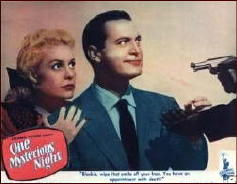
There are two things going for this movie, and Janis Carter is one of them, though how she manages to pop up every time the movie needs a boost in another direction, I’ll never know.
The other is the non-stop action that leaves absolutely zero time for reflection on how or why, only ever onward to the next scene.
Connoisseurs of sappy lunkhead comedy crime movies like this one should note that I am not including the so-called alleged humor as one of the positives. Picture this. The two main crooks are standing like dummies (no, I really mean dummies, or manikins, perhaps) in a pawnshop with the owner seriously wounded from a gunshot on the floor, while the two policemen they’re hiding from play cards in front of them while they’re waiting for the ambulance to come.
Well, I suppose you could call it funny. And do you know what? Right now I’m sitting here grinning like a nine-year-old!
Sat 25 Jul 2009
A 1001 MIDNIGHTS Review
by Bruce Taylor:
MARCO PAGE – Fast Company. Dodd Mead, hardcover, March 1938. Pocket #222, paperback; 1st printing, July 1943; Paperback Library 52-192, ca.1962. Film: MGM, 1938 (scw: Marco Page, Harold Tarshis; dir: Edward Buzzell).
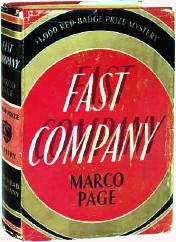
Harry Kurnitz (a.k.a. Marco Page) will be remembered, if at all, as a screen writer. He penned the weakest of the Thin Man films — The Thin Man Goes Home (1944 ) — but partially redeemed himself in 1957 with his excellent script for the screen adaptation of Christie’s Witness for the Prosecution.
His novels, including the bibliomystery Fast Company, have sunk into a more or less deserved obscurity. In this novel, rare-book dealer and part-time sleuth Joel Glass teams up with his wife, Garda, to solve the murder (referred to as “the blessed event”) of a much hated fellow New York book dealer.
It seems there are two main suspects in the killing of Abe Selig. The prime suspect is Ned Morgan, a former assistant of Selig’s, who happens to be a convicted book thief recently paroled from prison. Suspect number two is everybody else who ever met Ab Selig.
There are several other murders, and rare books keep disappearing and reappearing, but it’s all rather ordinary. There are some interesting glimpses into the world of rare books and book forgery.
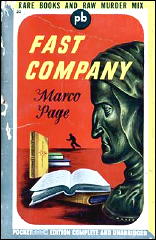
There is even an occasional good line: “[He] had an alibi tighter than a Scotch auditor…”
But the parts add up to less than the whole. The plot is predictable and doesn’t begin to live up to the “hard-boiled” promise of the dust jacket.
Fast Company was the winner of the 1938 Red Badge Best First Mystery Prize, which says something about the quality of the competition that year. It was made into a movie called Fast and Loose that same year (screenplay by the author) — an obvious attempt to capitalize on the success of the Thin Man series. The movie version isn’t very good either.
The other Marco Page novels are The Shadowy Third (1946), which also has a New York setting; and Reclining Figure (1952), which takes place in California.
———
Reprinted with permission from 1001 Midnights, edited by Bill Pronzini & Marcia Muller and published by The Battered Silicon Dispatch Box, 2007. Copyright © 1986, 2007 by the Pronzini-Muller Family Trust.
Editorial Comments: An earlier review of Fast Company by Bob Schneider appears here on the blog.
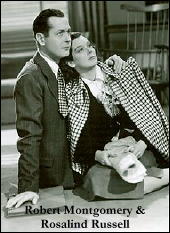
Question: It seems obvious that the movie Fast Company (MGM, 1938) was based on the book, and that’s the only one I’ve included in the bibliographic details so far. (See above.)
But both Al Hubin (in the Revised Crime Fiction IV) and Bruce Taylor say that Fast and Loose (MGM, 1939) was also based on Fast Company. Can both movies, made so close together, be based on the same book?
There was a third film in the same series, Fast and Furious (MGM, 1939). What’s remarkable about the three films is that they all had the same leading characters, Joel and Garda Sloane, but in each of the three outings there was a different pair of Hollywood stars playing the parts.
In order: Melvyn Douglas & Florence Rice; Robert Montgomery & Rosalind Russell; and Franchot Tone & Ann Sothern. I have all three on tape, probably from TCM at various times over the years, but I’ve yet to watch one.
[UPDATE] 08-08-09. On the ‘Golden Age of Detection’ group on Yahoo, Monte Herridge left the following comment:
“A sequel to
Fast Company was published in 1939:
Fast and Loose was serialized in 5 parts in
Argosy beginning in the February 25, 1939 issue.
“It may never have been published in hardback, but at least there is a sequel for those interested.
“The cover of Argosy for 2/25/39 describes the novel as ‘The Newest Hit from Hollywood!'”
And the release date for the film, for which Page (as Kurnitz) was the screenwriter, was 17 February 1939, making it difficult to say which came first, the novel or the screenplay. What you have to wonder the most about, though, is why the serial in Argosy was never published in book form.
Fri 24 Jul 2009
REVIEWED BY WALTER ALBERT:
SKINNER’S DRESS SUIT. Universal, 1926; Reginald Denny, Laura La Plante, Ben Hendricks, Jr., E. J. Ratcliffe, Arthur Lake, Hedda Hopper. Director: William A. Seiter. Shown at Cinevent 41, Columbus OH, May 2009.
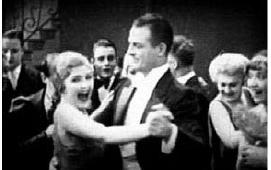
Skinner and Honey (Denny and La Plante) are a young married couple, with Skinner’s office job bringing in a salary that’s not up to Honey’s expectations of her husband’s worth. Egged on by his ambitious wife, Skinner finally works himself up to asking his boss for a raise.
Although the request is refused, Skinner finds himself incapable of confessing the failure to his wife, who immediately assumes he has the raise and starts spending down their savings on the expectation of the increased income.
Denny and La Plante gave such charming performances that it was difficult for me to find his wimpiness and her pushy nature distasteful. As their financial difficulties mount, an invitation to a fancy party proves to be their salvation, a plot turn fueled by their skill at the Charleston that leads to a dancing sequence that lifts this expertly directed and played comedy to new levels of effervescence.
Fri 24 Jul 2009
REVIEWED BY TED FITZGERALD:
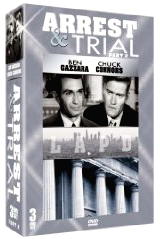
ARREST AND TRIAL. ABC-TV, 1963-64. Ben Gazzara, Chuck Connors, Roger Perry, John Larch, Don Galloway, Joe Higgins, John Kerr. On DVD: The Best of Arrest and Trial, Part Two, Timeless Media Group.
I was disappointed with this set of shows. This was the 90 minute 1963 ABC series that first tried out the Law and Order formula of having the first half chart the police work and the second half cover the resulting legal proceeding.
The difference here is that the second half focused on the defense attorney, rather than the prosecutors, in this case, Chuck Connors as “Irish” John Egan. Some critics said this undercut the show’s premise but I think it expanded the storytelling possibilities, although there are times you wonder which side of the street Egan is working.
What hurt the show, based on the nine episodes on view in this three-disc set, was its length. It was too long, it was sloooow, scenes dragged or were dragged out for padding. It was confusing as stories lost their way and guest stars like James Whitmore, John McIntire, Kim Hunter and Roddy McDowall gave great performances that were swallowed up in the maelstrom.
The writers didn’t seem to know how to write for the show’s length; potentially strong 60 minute stories became weak, discursive and ultimately boring behemoths.
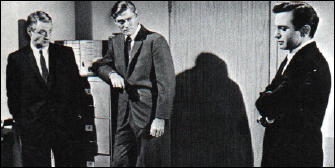
While Connors projected authority and had presence as Egan, Ben Gazzara phoned in his cop character, Nick Anderson. Anderson was an absolute cipher and Ben did nothing to flesh him out.
This isn’t so much a bad show as one that didn’t live up to its potential. There’s another box set out there, but I don’t think I’ll be looking it up.
Fri 24 Jul 2009
ERIC C. EVANS – Misconstrued.
Worldwide; paperback reprint, Feb 2003. Hardcover edition, 2001, Avalon Books.
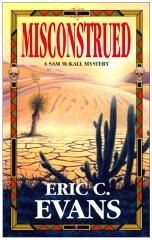
I was talking about coincidences a while back, and (such is the way of the world) here’s a book that’s built on — well, if not a story-making coincidence of title-making proportions, a killer who’s awfully serendipitous in his choice of victims.
Without letting the plot completely out of the bag, let me show you what I mean by quoting from page 217:
“It’s all so …” she said, searching for the right word.
“Unbelievable,” I said, fearing the worst.
“Well, yes, it is unbelievable, but the word I was searching for is … misconstrued,” she finally landed on it.
“Misconstrued?” I said, somewhat relieved.
“Yes, whoever is doing this to you is incredibly lucky,” she said.
Sam McKall, whose second recorded adventure this is, is the political aide to the governor of Utah, who (as the story begins) is trying to stop a nuclear waste dump being built on a Pishute reservation in the state. Pushed into investigating a series of deaths the police believe are only accidents, Sam and a reporter friend soon find themselves in what may be a huge conspiracy of corporate-based murder.
What puzzled me almost as much as the case they’re working on, which is smoothly told, in a totally workmanlike manner, is why the capital of Utah is referred to as Wasatch City. A minor matter. I’ve only been there once, and maybe it is.
What disappointed me was how the mix of cerebral detection with a modicum of action suddenly — with just over 20 pages to go — became an over-the-top (but non-pyrotechnic) thriller of Bruce Willis proportions.
And surely we didn’t need most of Chapter 23, which recaps the entire scenario, filling in details we already knew. Better than average, then, but not by much.
— April 2003.
Bibliographic data:
ERIC C(HARLES) EVANS
Endangered. Avalon, hc, 1999. Worldwide, pb, Jan 2001. Sam McKall.
The Key. Avalon, hc, 2000.
Misconstrued. Avon, hc, 2001. Worldwide, pb, Feb 2003. Sam McKall.
Fri 24 Jul 2009
Posted by Steve under
Reviews1 Comment
REVIEWED BY BOB SCHNEIDER:
MARCO PAGE – Fast Company. Dodd Mead, hardcover, March 1938. Pocket #222, paperback; 1st printing, July 1943; Paperback Library 52-192, ca.1962. Film: MGM, 1938 (scw: Marco Page, Harold Tarshis; dir: Edward Buzzell).

Marco Page, a pseudonym of Harry Kurnitz, 1909-1968, wrote or co-wrote 33 screenplays for Hollywood movies between 1938 and 1966. He wrote or adapted four plays for the stage between 1954 and 1963.
More importantly for the purposes of this review, he wrote four mystery/detective novels between 1938 and 1955. Fast Company was the first of these.
Of his screen work, Shadow of the Thin Man (1941) and The Thin Man Goes Home (1945) are the most telling of his style, because Page’s detecting couple in Fast Company is obviously based upon Nick and Nora Charles from Hammett’s novel The Thin Man (1934).
The plot of Fast Company revolves around some dirty business going on in New York’s rare book trade. A frame-up and an elaborate scheme for stealing, altering and re-selling valuable books are the main plot-drivers in this fast-paced mystery.
Rare book dealer Joel Glass (with help from his wife, Garda) discovers that working for insurance companies recovering valuable stolen books is more remunerative than depression era bookselling. The characters make prodigious amounts of wisecracks and drink prodigious amounts of liquor before the story is concluded.
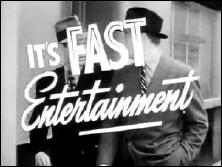
One would not think that so much gunplay, knife-throwing, fist-fighting, kidnapping, head-conking, pistol-whipping, book stealing and fem-fataling was going on in the 1930’s New York rare book milieu!
The best way that I can describe Page’s recipe is as follows: Combine one part Hammett’s Nick and Nora with one part screwball comedy with one part thriller-ish action and then add a tiny dash of fair-play clueing.
One plot point that really annoyed me was that, one day after a character is shot in the shoulder, he manages to free himself from being tied up, beats up a crook and jumps out of a second story window. It’s almost as if Page forgot that the character had been shot.
To be fair to Page, the general consensus of Catalogue of Crime and Twentieth Century Crime and Mystery Writers is that Fast Company is probably the weakest of his four mystery novels.

Still, it was good enough to win Dodd Mead’s second Red Badge Prize Mystery award and got him to Hollywood where three movies were made based on the lead characters of Fast Company.
Page/Kurnitz’s three other mystery novels are:
The Shadowing Third (1946), in which NYC lawyer, David Calder, searches for a stolen priceless violin.
Reclining Figure (1952), in which NYC art dealer, Ellis Blaise, investigates modern art forgeries in California.
Invasion of Privacy (as Harry Kurnitz, 1955), wherein movie studio rep Mike Zorin troubleshoots for his employers.
I have not read any of Page’s other work, but I’ll be on the lookout for his books just to see if he really did improve on his first effort.
Note: A very good review of Fast Company written on 05/09/08 by “prettysinister” on the LibraryThing website indicates that it was one of the earliest American bibliomystery novels. This doesn’t seem to be correct information. I will have to research further.
Coming soon: Another view of this book, taken from 1001 Midnights.
Fri 24 Jul 2009
DAN CANDY’S LAW. American International Pictures, 1974; aka Alien Thunder. Donald Sutherland, Gordon Tootoosis, Chief Dan George, Kevin McCarthy, Francine Racette, Ernestine Gamble. Director: Claude Fournier.
Based on an actual historical incident, and seemingly filmed on a budget of no more than two or three thousand dollars, this small movie filmed on location in Saskatchewan, Canada, still packs a remarkable punch.
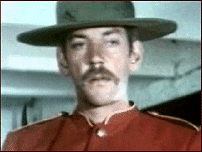
The movie, set in 1885, is based on the true story of a Cree Indian named Almighty Voice (Gordon Tootoosis), who after being arrested for killing one of the Queen’s cows, escapes from jail and kills the Mountie who goes after him.
Leading his pursuers a merry chase for over a year with the unspoken help of his fellow tribesmen, his primary nemesis is Constable Dan Candy (Donald Sutherland).
Filled with guilt for his laxness in allowing the prisoner to escape and for allowing his fellow officer (Kevin McCarthy, in a very brief role) to go out after him alone, Candy is obsessed with bringing Almighty Voice in, even to the extent of refusing orders and come back in by his commanding officer.
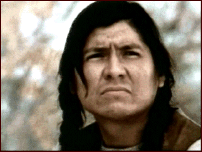
The ending is both quite a shocker and very poignant, as some truly heavy artillery is brought in, with a multitude of town folk and native people standing and watching quietly up along the skyline above. It’s authentic, it’s moving, and it’s painful to watch.
The setting is as authentic as in any western I’ve ever seen. It is as if someone with my father’s home movie camera in the 1940s went back in time and filmed the entire movie on location in grainy, faded color, complete with roughly constructed buildings with unpainted wooden shingles such as those I grew up seeing in my grandparents’ photo albums. I could swear that one of the children had a snowsuit on just like the one I had when I was six years old.
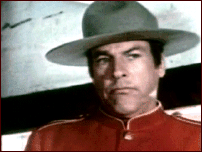
Donald Sutherland, already an established star, turns in a remarkable performance for a salary that must have been peanuts, even in 1974.
As a teller of tall tales, fully mustachioed, in one telling scene Dan Candy relates the son of the man who was killed a story about himself as a youngster and the privy his family had with a tar paper roof. In the summer when it got hot, birds would land on it and get stuck. After enough birds found themselves trapped on the roof, they all flew away with the outer building stuck to their feet and with his father still sitting there with his pants around his ankles, and that is how he remembers him, as he breaks down in tears.
Beware by all means, though, if it’s possible, of the DVD produced by Mill Creek Entertainment. Whoever did the transfer knew nothing about scan and pan or any other enhancement that might indicate any sense of professionalism in their chosen line of work. In close-up many faces are sliced in half or worse, and sound effects are often heard but have no appreciable visual connection with what’s seen on the screen.
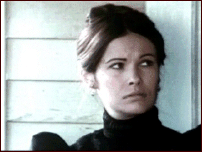
The story line itself moves from scene to scene rather abruptly. I won’t blame the transfer guy for that, and once it’s gotten used to, it’s paradoxically as though the low grade production values only enhance the story.
I don’t think I can explain any further. All I can do is repeat myself by recycling much of what I’ve said already. In spite of its many flaws, whatever their causes, this is a movie that feels authentic, it’s moving, and if you stay with it, the ending is one that’s painful to watch — and all the more so because you know it’s one that’s coming.
Thu 23 Jul 2009
Posted by Steve under
Reviews[18] Comments
A REVIEW BY CURT J. EVANS:
CAROLYN WELLS – Feathers Left Around. J. B. Lippincott, US/UK, hardcover, 1923.
Perhaps the most perfect example of the stereotypically bad English country house mystery that I have read was published in 1923 by an American, Carolyn Wells. Sure, Feathers Left Around takes place in America, but it might as well be in the England of the classic Golden Age country house fantasy land of stereotype.
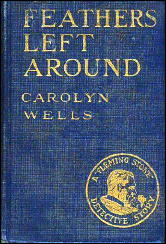
The best thing about the tale is the whimsical title, the meaning of which we learn from this racially insensitive anecdote from one of the characters, the soon-to-be-murdered detective novelist, Mr. Curran:
“An old darky was arrested for stealing chickens, and he was convicted on circumstantial evidence. ‘What’s circumstantial evidence?’ a neighbor asked him. ‘Well,’ he said, ‘ez near as I can splain f’um de way it’s been splained to me, circumstantial evidence is de feathers dat you leaves lyin’ roun’ after you has done wid de chicken.'”
So the “Feathers” in the tale are the clues left around after Mr. Curran is found dead in a locked room, presumably murdered. About 80% of the novel is devoted to the bumbling efforts of a lone police detective and a surfeit of amateurs (five or more!) to solve the case, until Fleming Stone and his “saucy” boy assistant Fibsy show up to solve the case in short order.
If this suggests that the mystery is a pretty simple one, you’re right. I penciled the solution in the margin on page 102, but had to wait about 240 pages for confirmation (I was right).
No secret passages this time, but another trick that was used, with far more elaboration, by later authors John Dickson Carr and Nicholas Blake. This is the most interesting part of the book as far as plot is concerned, and might have made a mildly interesting short story. The murder method is fairly clued too, though the motive is deduced by Fleming Stone based on information not provided to the reader.
Unfortunately, the novel is padded with ceaseless dialogue among a group of completely uninteresting ciphers, which soon becomes tedious. None of the men, with the exception of the imperious host of the house party, are really distinguishable, while one wishes that the women were extinguishable.
There’s the pouty flirt who wraps all men around her finger (even the police detective, who, enchanted by the little lady’s pouts and simpers, agrees to lie about her having enjoyed a tete-a-tete out on the balcony with the deceased shortly before he died); the obvious heroine with a not-so-dark and easily-guessed secret; and the girl who likes to talk about her dreams and the utterly unconvincing Russian Countess. ( “Fiddle-dee-dee!” the Countess exclaims exotically at one point.)
It becomes clear that there’s not a chance the author will allow one of these darling women to be the killer, their obviously being intended merely to provide “character interest” window dressing (variously humor and anxiety, as the case calls for).
The author’s frivolous treatment of her female characters is further indicated when the men of the party inform the women that they are not allowed to investigate the murder scene for clues, this being man’s work, and the women submissively assent. Agatha Christie, where are you!
Most fascinating about Feathers Left Around are the author’s attitudes about gender and especially class. It seems clear Wells has no clue what an actual police investigation is like, or, if she does, she determinedly keeps that knowledge to herself.
When the five or so men of the party inform the detective that they want to accompany him to the scene of the crime to look for clues, the detective happily acquiesces, even though it’s quite apparent that one of these men may be the murderer.
When the police detective comes to suspect that the fiancee of the house party host is implicated in the crime, the latter man orders the detective out of his house and threatens to kill him if he doesn’t leave. The detective meekly retreats.
He does, however, terrorize the housemaids and threaten them with life imprisonment on bread and water in rat-infested jails if they do not answer his questions, and even allows one of the “gentlemen” to treat them so as well. (These scenes clearly are intended to be amusing.)
In terms of social attitudes conveyed by the author, it could be England in 1860, with the police investigating the Constance Kent case. It’s instructive to compare this novel with the hardboiled tales that have come to represent American mystery — the contrast is remarkable.
Far more than most Golden Age British tales I have read, Feathers Left Around strikes me as a real relic from the nineteenth century. That novels like this had a decent following (mostly female, judging by the book ads in the back of the book) suggests there was a significant conservative mystery audience in the United States as well as in Britain.
Unfortunately, the novel also suggests that, though she may have had some mildly interesting plot ideas, Wells did not offer much else to engage the reader, aside from the sociological standpoint. Wells seems rather like an American Patricia Wentworth, though even the cozy Wentworth gives a more rigorous read, in my experience.
I want my next Wells to come from near the end of her career (her last novel was published in 1942) to see if the events of the thirties ever induced her to modernize her style. Or was she still holding those same endless country house parties with the same boring society people during the Great Depression and World War Two?
Thu 23 Jul 2009
A MOVIE REVIEW BY DAVID L. VINEYARD:
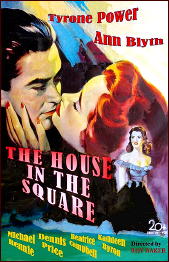
I’LL NEVER FORGET YOU. 20th Century-Fox, 1951; aka The House in the Square (British title). Tyrone Power, Ann Blyth, Michael Rennie, Dennis Price, Beatrice Campbell, Raymond Huntley. Screenplay by Ranald MacDougall, based on the play Berkeley Square by John Balderston. Director: Roy Ward Baker.
This is an old favorite of mine that is available for the first time on DVD. It’s based on the hit play Berkeley Square which was filmed earlier with Leslie Howard, and once I start to discuss it, the plot will seem familiar. It has been used countless times, but this is based on one of the original sources.
In this version, Power is Peter Standish, a nuclear physicist in England working on a secret project. His work and the birth of the atomic age have left him a lonely man, and one rather fed up with this world and this time. When he meets Roger Forsyth (Michael Rennie), they hit it off, and he learns that Forsyth’s old family home was destroyed in the Blitz but some of it still stands. He agrees to meet Forsyth to see the old place that stood in fashionable Berkeley Square.
Arriving before Forsyth, but after dark, he feels a strange tie to this place. A sense of déjà vu as if he had been here before. Wandering through the ruins he spots a surviving portrait still hanging over the remains of a hearth.
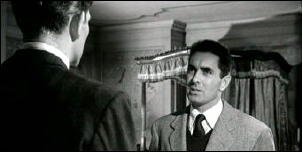
The painting is of a beautiful woman and mesmerizes him. But when he moves on, he upsets some of the rubble and is knocked unconscious.
And when he wakes up, he is in England of the 18th Century, the age of the Enlightenment and the birth of the modern scientific age. And by the way the film is suddenly in brilliant technicolor instead of the drab black and white of the introduction. Cinematic shorthand for how Power views his own world and time and the past as he sees it.
Nothing new, the technique was used most famously in The Wizard of Oz and both Portrait of Jennie and Hitchcock’s Spellbound used color briefly for it’s visual qualities.
He meets Forsyth’s ancestor and the girl in the portrait, Ann Blyth, with whom he is already half in love, the wife of wastrel Tom Pettigew (Dennis Price).
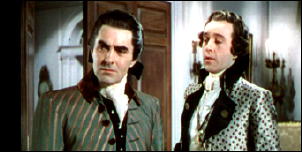
Passing himself off as a Colonist to explain his accent, he puts his talents as a scientist to work to become something of a sensation with his wonders, but he draws too much attention, is accused of witchcraft, and is nearly killed.
When he comes to he is again in postwar drab black-and-white England, having been found by Forsyth and his sister — Martha (Ann Blyth). The look between the two is enough to tell you that love has survived across time and they will finally be joined together.
Music rises, fade out …
This sort of romantic nonsense has been knocking around for quite a while. It’s pretty much the theme of George DuMaurier’s Peter Ibbetson, is touched on by some of Marie Corelli’s novels, is part of the fascination of Rider Haggard’s She, and shows up in novels like Edwin Lester Arnold’s Phra the Phoenician. John Dickson Carr used it in one of his best historical mysteries Fire Burns and to some extent in The Burning Court.
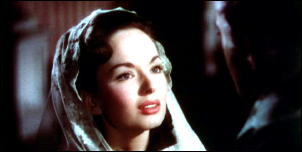
For that matter it is pretty much how Edgar Rice Burroughs John Carter gets to Mars — a combination of wish fulfillment Madame Blatavasky, Theosophy, reincarnation, and the whole fascination with the occult that played such a role at the end of the 19th and the beginning of the 20th Century. Love conquers all and survives even death.
As late as Richard Matheison’s Somewhere in Time it still enthralled audiences as Christopher Reeve and Jane Seymour struggled with love across time and past lives.
I’ve never seen Berkeley Square (1933), so I can’t say if this is as good a telling of the tale as the Leslie Howard film. It’s simply one I’ve seen perhaps a dozen times since I was a child, and it has always touched some chord with me.
It may seem at best a rather tired fantasy to you, and that’s fine. But if you let it, the film has a charm all its own. Similar films include Enchantment with David Niven and even the Archers’ Stairway to Heaven, and the musicals Brigadoon and to a lesser extent Finian’s Rainbow.
I confess I’m a sucker for them all. Probably my Highlander ancestors. All that Scotch and fog — you tended to see things. Cynical realists are warned to stay away.
But if you ever one day dreamed of a another time or wanted to escape into a more romantic and less mundane world this is a good vehicle for it. It’s a bit like Shangri La, Brigadoon, or even forgotten Kor, it’s there to be found if only in your heart.
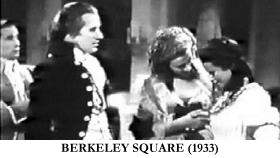
I make no excuse for it as film art. It is quite simply a movie I love, whatever its flaws or failures, and there are few enough of those for any film lover.
Note: The 1933 version was directed by Frank Lloyd with Leslie Howard, Heather Angel, and Samuel S. Hinds. And anyone familiar with their Noel Coward will know the pronunciation is Barkley as in his popular song “A Nightingale Sang in Berkeley Square” that became a sort of anthem for WW II England.
« Previous Page — Next Page »












